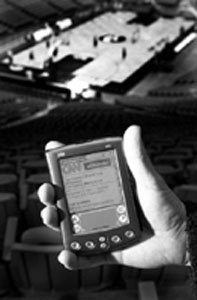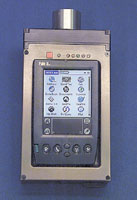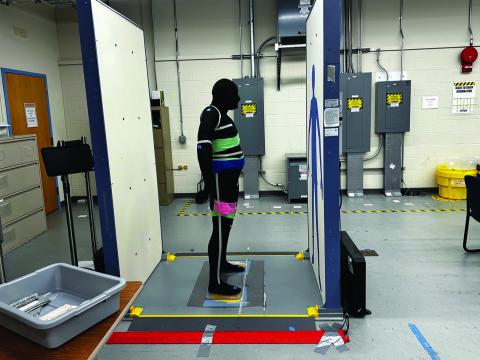Personal Assistants Aid Security
 |
Security personnel at large venues such as sporting events can search for terrorist suspects and identify suspicious individuals while roaming through crowds by accessing criminal databases via a personal digital assistant. |
Personal handheld devices are supporting antiterrorism and homeland security measures for users from military base guards to emergency first responders. The wireless capability, durability and portability allow different levels of government and first responders to communicate not only quickly but also accurately.
The September 11, 2001, attacks proved just how vital the need for fast dissipation of information and instructions is to a joint response effort to a crisis. During the attacks, many first responders and local government radio and cellular telephone systems were either knocked out or unavailable because of the high volume of traffic. Personal digital assistants, or PDAs, offer an alternative means of communications and information dissemination during such an event, with their variety of features such as telephone, wireless Internet and camera capabilities. Photographs and information can be uploaded to a server that all organizations can access, and data also can be transferred between units.
According to John Inkley, director of federal sales for palmOne, Vienna, Virginia, the handheld screens offer more than 300 dpi in resolution for good visibility, and the user simply taps on icons to move through the programs. There is no need to type in “www,” for example, and all necessary information can be stored in advance. Video is possible; however, Inkley admits that the amount of power needed is too great to warrant reasonable usage.
Handhelds can provide access to databases for those who need to stay mobile yet plugged in. For example, security guards can use PDAs at sports functions and other large-scale events to identify potential terrorists or gain information about suspicious individuals.
Security personnel can run background checks immediately, with or without identification. “If the suspicious person is in possession of a weapon, the officer can immediately verify if the gun is registered, to whom and if it is linked with any previous crimes,” Inkley says. The information collected is then sent to the main database for record keeping in case the individual comes under scrutiny again.
Handheld devices can pull information from a number of databases to aid in homeland security. For example, at the 2002 Olympic Winter Games in Salt Lake City, held less than a year after the September 11 attacks, more than 200 security officers were equipped with handhelds that had access to criminal and Department of Motor Vehicles databases, including photos of suspected terrorists.
Wright-Patterson Air Force Base, Ohio, has been using PDAs at the gates and on patrol since May 2003. Previously, soldiers were provided with an events authorization list each day, which included all the base guests and their sponsors’ contact information. The lists were in thick binders that usually were kept only at three of the 10 gates. Guards stationed at gates without binders would have to go to another gate or wait for someone to radio in and confirm whether a guest was allowed onto the base.
Now, the base can place all of this information on a PDA and can include additional data such as a list of people who are prohibited from entering the base. The PDAs also can include procedures from quick reaction cards, which are small cards that guards wear on their belt for quick reference. Before the soldiers began using the handhelds, not only did the increasing number of cards take up more and more space on the belt, but also the cards were difficult and cumbersome to update, explains Michael Barry, handheld business solutions manager, Materiel Systems Group, Wright-Patterson. All the information on the handheld is updatable at any time.
While not purely a defense application, another feature of the device provides base guests with driving directions. The guard types in the current location and destination, and the application on the handheld provides verbal step-by-step instructions. The guard also can point the handheld’s infrared beam at a printer to print the directions.
Wright-Patterson chose the palmOne m515 handheld because of its long battery life, durability and low cost, Barry says. “The battery was important because some of the guards are using the handhelds for 14 hours on patrol and cannot easily recharge them. Also, the extendibility with the expansion slot and the high resolution, brightness and clarity of the screen outdoors in both daylight and night were good,” he offers.
In addition to the PDA’s own features, software programs are available for handhelds that contain information that would be critical at the site of a biological or chemical attack. A first responder could arrive at a scene, enter information such as a victim’s symptoms or area damage into the device and access data on biological or chemical agents and their effects along with data about the potential danger and how to respond. Finally, the unit can take pictures at the scene and relay them to other organizations or government agencies.
Handhelds also are being modified to become field tools. At Los Alamos National Laboratories, Los Alamos, New Mexico, researchers have developed a radiation detector that works with a PDA. According to William Murray, lead scientist and developer for the CZT Spectrometer, Advanced Nuclear Technology, Nuclear Nonproliferation Division, the nuclear threat has raised concerns and stimulated thought about how to detect and deter nuclear terrorism.
 |
Handhelds such as the CZT Spectrometer can run initial tests for the presence of harmful radiation, enabling first responders to evaluate the scene of a crisis event and provide information immediately to local and federal government officials. |
The portability of handheld devices allows first responders to begin to perform radiation tests faster. The sooner the radiation level, its source and its type can be determined, the quicker emergency organizations can ensure the safety of people within a contaminated area.
Although the device performs some analysis, the information also is transferred to a main database for verification and more in-depth research. All information, including unknown readings, is recorded in a main database for additional evaluation such as to study trends. In the future, the devices will be programmed so that when a radiation source is identified, information on treatment and response instructions can be downloaded by emergency personnel.
The CZT Spectrometer is part of the U.S. Department of Energy’s Radiological Assistance Program (RAP). Forty units have been deployed to RAP, which provides personnel and equipment to evaluate and assist radiation hazards and risks at the request of federal agencies; state, tribal and local governments; and private organizations as well as individuals.
Because handheld devices transmit information among key agency officials and first responders, information must be kept secure. “Security is the biggest concern for my federal clients,” Inkley says. “Between the security on the palmOne handhelds and the various security programs available, we are able to meet the government security standards.” Handhelds come with device-level encryption, and applications from solution providers enable additional layers of security. For example, a user can set up the handheld so that if he or she loses it and someone tries to enter an incorrect password three times, all the data will be wiped from the device.
According to Inkley, handheld devices are not only more compact but also more secure than laptop computers. “PC [personal computer] drives are not set up to erase themselves. And, hard drives are not password-protected, so anyone who picks up a laptop computer would be able to pull information off the drive using a fairly simple hacking software program.”
Additional security features on the units include application-level encryption and power-on password capabilities. A 128-bit encryption technology enables users to choose which applications they want encrypted. In addition, password-character blocking keeps bystanders from seeing keypad entries while the device is booting, and scheduled or regularly timed lockouts protect data when the device is not in use.
Inkley claims that if someone gets beyond the password on the PDA, it would still be nearly impossible to access any of the databases and browse or alter the information because each unit has a password protection program. A PDA device can be denied access to remote servers immediately once database operators are notified that it is missing.
Although handheld devices are being used by various government agencies, the full use is yet to be determined. “While we cannot comment on specifics, handhelds are used by the Secret Service, the departments of the Treasury and Homeland Security and among other government organizations,” Inkley says.
The CZT Spectrometer has not reached its full potential either, according to Murray. Handhelds are not a solution but a tool that can provide further defense and reaction capabilities for the United States against terrorist threats. Terrorism is not going to end with the latest technology, but the technology will make a difference, he adds. “Terrorists want to create havoc. And terrorists are determined to make it happen,” Murray points out. “We just have to be more determined to make it more difficult for them to do it.”




Comments